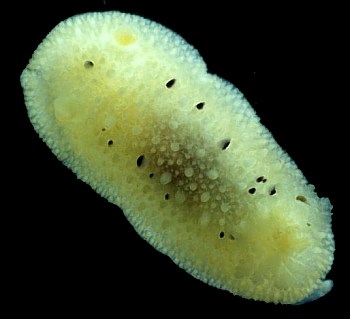
Archidoris montereyensis
(Cooper, 1862)
Order: NUDIBRANCHIA
Suborder: DORIDINA
Superfamily: EUDORIDOIDEA
Family: Dorididae
DISTRIBUTION
Alaska to San Diego, California.
PHOTO
UPPER: Moss Landing, California. Photo: Ángel Valdés.
Similar in shape and colour to Anisodoris nobilis there are a few external differences which can be used to identify them. In Anisodoris nobilis the gills are white-tipped and black or dark brown pigment, if present, does not occur on the tubercles. In Archidoris montereyensis the gills are the same yellow colour as the mantle and dark pigment often darkens some of the tubercles. See Bruce Wight's message comparing the two species.
Reference:
• Cooper, J.G. (1862). Some new genera and species of California Mollusca. Proc. California Acad. Nat. Sci., 2: 202-207
Rudman, W.B., 2000 (October 6) Archidoris montereyensis (Cooper, 1862). [In] Sea Slug Forum. Australian Museum, Sydney. Available from http://www.seaslugforum.net/find/archmont
Related messages
Re: White variation of Doris montereyensis ?
May 8, 2006
From: Jeff Goddard
Concerning message #16457:
Hi Bill and Dave,
I'm not so sure any of the specimens in the top two photos of message #16457 are Doris montereyensis. The relatively small, low, rounded tubercles and patches of dark pigment look more like Geitodoris heathi or Peltodoris lentiginosa to me. I think that dissection would be needed to determine the identity of all three of those specimens. However, the specimens in the bottom photo are clearly Doris odhneri, which has both yellow and white color forms, lacks dark pigment and has broader dorsal tubercles.
Best wishes,
Jeff
goddard@lifesci.ucsb.edu
Goddard, J.H.R., 2006 (May 8) Re: White variation of Doris montereyensis ?. [Message in] Sea Slug Forum. Australian Museum, Sydney. Available from http://www.seaslugforum.net/find/16479Hi Jeff,
Well so much for trying to clear up matters. I wish I could be as definite as you, but I cannot. Jan has promised to collect examples of these specimens/colors, and I will pull the radula, and see what I can determine.
Only problem is that the radula didn't help when Sandra ID'd the P. lentiginosa, as counts overlap completely with other species.
We'll certainly post our findings as soon as we can. Appreciate the wrench in the monkey works.
Best wishes,
Dave Behrens
White variation of Doris montereyensis ?
April 28, 2006
From: Jan Kocian
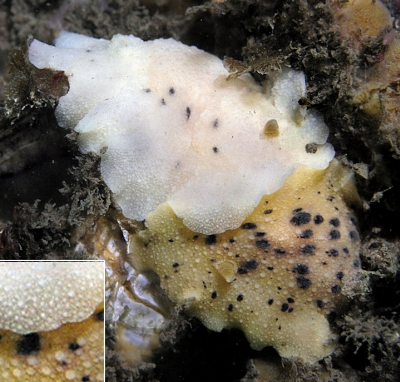
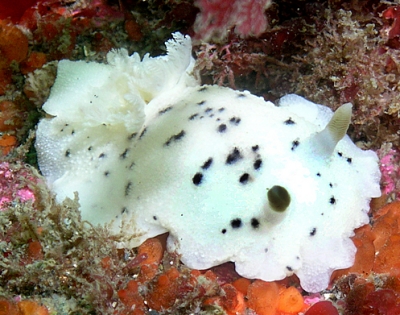
Hello Bill:
While the majority of the Doris montereyensis I encounter during my dives on Whidbey Island are yellow, at one location there are some which are of the white variety.
Locality: Rock jetty, 20 feet, Washington, USA, Puget Sound, NE Pacific Ocean, 8 February 2006, rocks. Length: 35mm. Photographer: Jan Kocian.
Jan Kocian
honkoc@hotmail.com
Kocian, J., 2006 (Apr 28) White variation of Doris montereyensis ?. [Message in] Sea Slug Forum. Australian Museum, Sydney. Available from http://www.seaslugforum.net/find/16457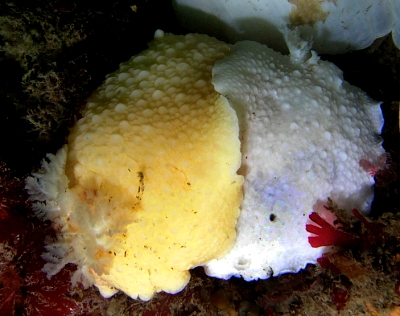
Hi Jan,
Just when I thought we were getting to the bottom of the GDNEPYD's (that Gosh darn north eastern Pacific yellow dorids), you dig up this series. Awesome finds, but confusing still.
The top photo is clearly a pair of Doris montereyensis. Althought the dorsal tubercles look smaller on the white specimen, than on the yellow specimen (of course the inset compares the edge of the white mantle to the mid-dorsal of the yellow), all other characters match, D. montereyensis.
Now the second photo. I have always considered this D. montereyensis, but at Bill's suggestion Jan, we need to do some internal work to make the final call. Can you collect two specimens for me to dissect? Thanks.
The lower photo again is puzzeling. The dorsal surface looks like D. montereyensis, but with no spots at all, this is quite uncharacteristic. The tubercles are too large to be Peltodoris lentiginosa, but I do see what almost appears to be a few slightly darker patches of color on the dorsum, similar to P. lentiginosa. I think you need to collect two of these also.
Thanks Jan.
Darn - GDNEPYD's
Best wishes,
Dave Behrens
Doris montereyensis from Monterey, CA
April 27, 2006
From: Clinton Bauder

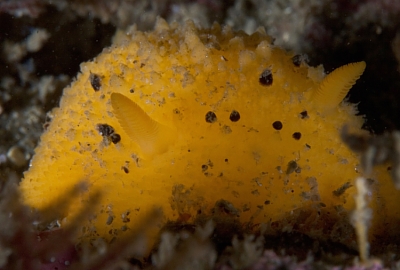
Hi Bill,
As part of the ongoing discussion around yellow and white dorids from the West coast of North America I went looking for Geitodoris heathi and Doris montereyensis. The yellow slug in this message is the typical D. montereyensis. Dave Behrens has ID'd the white one as being D. montereyensis also. I believe Jan Kocian has some nice shots showing white and yellow animals mating which make the case pretty strongly as the yellow animals are quite typical of D. montereyensis.
If these white dorids are D. montereyensis it seems that my photo [message #3166 top right photo] which is now on the front page for Geitodoris heathi should be moved to the page for D. montereyensis or at least moved off of the front page for Geitodoris and tagged as being questionable.
For comparison I've included 3 shots of Geitodoris in a separate message [#16297 ].
All of the photos were taken by my friend Mike Jimenez.
Locality: Shale Beds, Monterey, 18 meters, CA, USA, Pacific, 8 April 2006, Shale Reef. Length: 50-60mm. Photographer: Michael Jimenez.
Clinton
gecko1@apple.com
Bauder, C., 2006 (Apr 27) Doris montereyensis from Monterey, CA. [Message in] Sea Slug Forum. Australian Museum, Sydney. Available from http://www.seaslugforum.net/find/16296
Hi Clinton,
Straightening out the many messages here on the Forum showing variations (many hard to identify at all) of yellow dorids from the eastern Pacfic Ocean, will take some time. This is a great start however.
Yes, these are very typical D. montereyensis as noted by the black pigmentation covering the dorsal tubercles. Also characteristic is that the color of the rhinophores and gill match the color of the body. Also note the pointed shape of the tubercles in Michael's great photos.
Hopefully Jan will send us his examples of white and yellow color variants, occurring together. It is interesting to note that the occurrence of the white variant is becoming more and more common, thus all these questions from Branchers. I am not sure I had ever seen this color 20 years ago.
Thanks,
Dave Behrens
===================
PS: Hi Clinton, I agree your photo of the white & yellow animals shouldn't be left on the Geitodoris heathi Fact Sheet - if the experts aren't sure of its identity its not much use as a guide to the uninitiated. I've moved it from the Fact Sheet but of couse it's still in your message #3166. ..... Bill Rudman
Behrens, D.W., 2006 (Apr 27). Comment on Doris montereyensis from Monterey, CA by Clinton Bauder. [Message in] Sea Slug Forum. Australian Museum, Sydney. Available from http://www.seaslugforum.net/find/16296Re: Diaulula sandiegensis? from Puget Sound
March 31, 2006
From: Clinton Bauder
Concerning message #16150:
Hi Dave,
At some risk of opening a can of worms I wonder if I can revisit an earlier "Sea Lemon" post? Specifically I was thinking that the (one yellow and one white) animals shown mating in the lower image for the Geitodoris heathi Fact Sheet are actually D. montereyensis? Certainly they look very similar to my amateur eye and it isn't clear to me from the text of the various messages how to tell the difference.
What I usually ID as Geitodoris heathi is quite common at some of my favorite dive sites and I see a lot of them. Usually these animals have very fine black specks on the dorsum. Some have large black spots as well but nearly always the fine specks as well. Also the base color of the body is usually blotchy rather than solid. Somehow also the contrast between the spots and the base color seems less than in Doris montereyensis. Geitodoris usually looks like it has a fine layer of silt covering the mantle - ie it looks dirty or dull somehow.
On the other hand Doris montereyensis has large spots with none of the fine specks and the base color is very uniform rather than blotchy. White examples of this species are unusual but I have seen them. Usually this species looks bright to the eye rather than dull like Geitodoris.
I realize these differences are rather subjective and it may be that distinguishing these species without dissection is difficult but I'm hoping for a reliable method to choose between the two.
Thanks,
Clinton
gecko1@apple.com
Bauder, C., 2006 (Mar 31) Re: Diaulula sandiegensis? from Puget Sound. [Message in] Sea Slug Forum. Australian Museum, Sydney. Available from http://www.seaslugforum.net/find/16190Hi Clinton,
Well I can't disagree with you - this complex of yellowish dorids (I hate the name Sea Lemon) is difficult to identify. Each of the species you mention is highly variable in color, creating the problem. Let's discuss what is NOT varible.
So let me propose -- Sea Lemon 101:
Doris montereyensis - black spots on the dorsum cover the tubercles. Tubercles are not uniform in size. Gill yellow.
Peltodoris nobilis - dorsal tubercles nice and round and uniform. Black spots are on the dorsum and do not extend up onto the tubercles. Gill white.
Geitodoris heathi - Dorsal tubercles low and widely separated. Has MINUTE brown-black flecks on the dorsum, especially in a patch in front of the gill. None of the others have this. These same flecks occur of the gill plumes and rhinophores. Again not on the other species.
Peltodoris lentiginosa - a northern species north of Cape Arago, Oregon. Should not be a problem in Monterey, California. Color varies from pure white to white with large brown patched. Tubercles are low, and are visible through even the darkest patches. Gill is white.
Now with this said, PLEASE keep in mind that variabilty between specimens as seen in your message #3166 will continue to cause us confusion. Visual ID's are always difficult, but I can tell you that internally these species are completely distinctive.
Thanks for keeping us on our toes,
Dave Behrens
Diaulula sandiegensis? from Puget Sound
March 27, 2006
From: Jack Connick
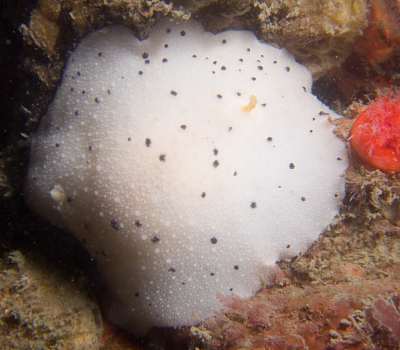
Hi Bill;
Looking for an id on this guy. About the closest I can find is Diaulula sandiegensis, and Dave Behrens notes that the spots can be different or missing. If so, you might want to add it to your photo collection.
Locality: Rosario Beach - Urchin Rocks, Deception Pass State Park, 30', Washington, USA, Rosario Strait, Puget sound, Pacific ocean, 18 March 2006, Rocky crevice. Length: 3.5". Photographer: Jack Connick.
Jack
JackConnick@Yahoo.com
Connick, Jack, 2006 (Mar 27) Diaulula sandiegensis? from Puget Sound. [Message in] Sea Slug Forum. Australian Museum, Sydney. Available from http://www.seaslugforum.net/find/16150
Dear Jack,
Actually this is the white variation of Doris montereyensis (previously Archidoris montereyensis). This white variation always confuses folks, so don't sweat it. Diaulula has a velvety looking dorsal surface due to the spicules protruding from tiny tubercles. Doris has much larger, rounded tubercles like in your photo. Just like the common yellow form of this species, the black spots extend over some of the tubercles.
[PS: I will sort out the generic changes on the dorid Fact Sheets when I get a chance - Bill]
Best wishes,
Dave Behrens
Doris montereyensis feeding
March 16, 2006
From: Jan Kocian
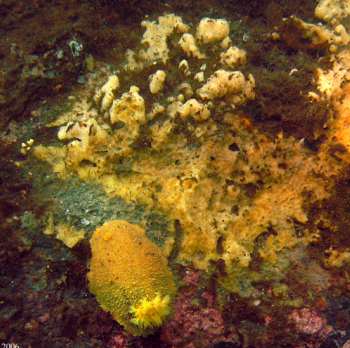
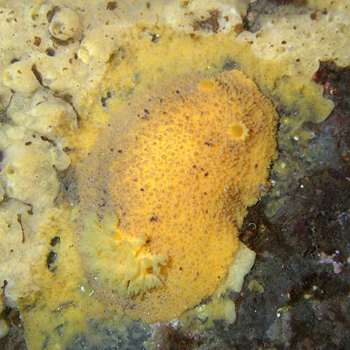
Hello Bill.
During recent dives I kept watching a lonely Doris montereyensis working over a small patch of yellow sponges I believe to be Halichondria panicea. I was amazed it did not venture anywhere in the two week period, but sure did a dent in the sponge.
Locality: Jetty, 20 feet, Washington USA, Puget Sound,NE Pacific Ocean, 09 March 2006, rocks. Photographer: Jan Kocian.
Sorry about the quality of pictures, I am having problem with my strobe.
Jan
honkoc@hotmail.com
Kocian J., 2006 (Mar 16) Doris montereyensis feeding. [Message in] Sea Slug Forum. Australian Museum, Sydney. Available from http://www.seaslugforum.net/find/16090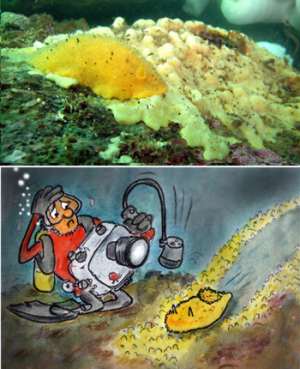
Dear Jan,
When you see one of these sponge-feeding dorids making a very obvious meal of a sponge colony you wonder why it so difficult to build up good information on their feeding. Unfortunately their activity is often not so obvious.
Best wishes,
Bill Rudman
Archidoris montereyensis from California
January 25, 2005
From: Bruce Wight
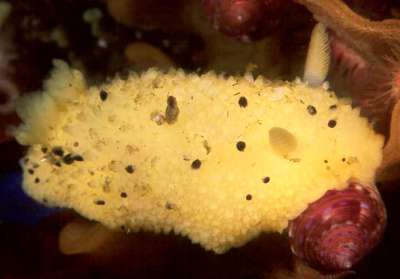
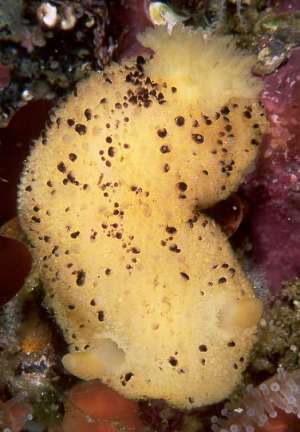
Dear Bill,
Here are some photos of Archidoris montereyensis from San Miguel Island, California taken in July 2004.
Bruce Wight
bruce.c.wight@boeing.com
Wight, B.C., 2005 (Jan 25) Archidoris montereyensis from California. [Message in] Sea Slug Forum. Australian Museum, Sydney. Available from http://www.seaslugforum.net/find/12717
Thanks Bruce,
I've included a close-up alongside showing how in this species, the black pigmentation is often on the tubercles
Best wishes
Bill Rudman
Archidoris montereyensis feeding
July 15, 2004
From: Jackie Hildering and Glen Miller
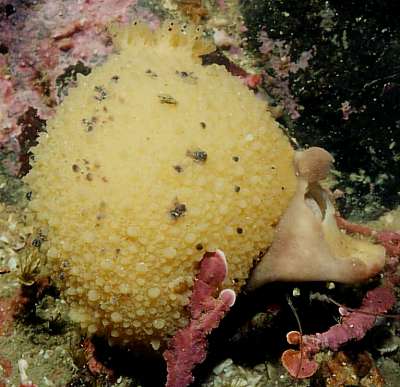
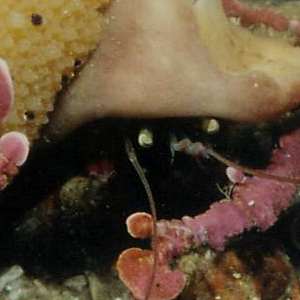
Dear Bill,
Here what I believe to be Archidoris montereyensis is feeding on Suberites suberea (the hermit crab sponge). Note the hermit crab below. We saw a second scene like this too with two A. montereyensis on one S. suberea. It does not appear that being a mobile sponge is highly successful in escaping predation!
Dive: Bear Cove, Northern Vancouver Island, British Columbia, Canada
Depth: 40’
Photographer: Glen Miller
Date: March 21st, 2004
Jackie Hildering
earthent@telus.net
Thanks Jackie & Glen,
I wonder what the crab is thinking? It would be interesting to have some feedback on this observation. Bloom (1976) notes it sometimes feeds on Suberites ficus (Johnston) but its not a preferred food species and Goddard (1984) notes finding it 'on' Suberites sp. a couple of times. It would be interesting to know if others have made similar observations
• Bloom, S. A. (1976) Morphological correlations between dorid nudibranch predators and sponge prey. The Veliger, 18(3): 289-30
• Goddard, J. H. R. (1984) The opisthobranchs of Cape Arago, Oregon, with notes on their biology and a summary of benthic opisthobranchs known from Oregon. The Veliger, 27(2): 143-163.
Best wishes
Bill Rudman
Re: Archidoris montereyensis with sculpin
September 8, 2003
From: Brian K. Penney
I would most likely say the animal is Anisodoris nobilis (more properly, what was formerly Anisodoris). Pigment in between tubercles rather than extending on top is a key distinction between this species and Archidoris montereyensis and Diaulula sandiegensis is out, as this specimen does not have caryophyllidia.
On that note, I am curious for an opinion from the systematists: what exactly do we call A. nobilis now? I know the genus name has been declared redundant by Valdes and Gosliner, but this species doesn't have caryophyllidia and therefore also cannot be placed in Diaulula. Should we just stick to Anisodoris until someone revises the species?
Cheers,
Brian
bpenney@anselm.edu
Panney, B.K., 2003 (Sep 8) Re: Archidoris montereyensis with sculpin. [Message in] Sea Slug Forum. Australian Museum, Sydney. Available from http://www.seaslugforum.net/find/10921Dear Brian,
Concerning the identity of this animal - I think I'll move it to Diaulula nobilis, unless anyone has any stromg objections.
Concerning Anisodoris nobilis versus Diaulula nobilis, I can only refer you to an earlier message. Perhaps Angel or Terry can give some more information.
Cheers
Bill
Re: Archidoris montereyensis with sculpin
September 7, 2003
From: Phil Cromwell
Bill/Marli,
I would think this slug is more likely Diaulula nobilis due to the dark markings on the background of the mantle instead of on the tubercles.
I could be wrong, but I haven't seen Archidoris montereyensis with this type of marking.
Cheers,
Phil
chiron42@msn.com
Cromwell, P., 2003 (Sep 7) Re: Archidoris montereyensis with sculpin. [Message in] Sea Slug Forum. Australian Museum, Sydney. Available from http://www.seaslugforum.net/find/10907Thanks Phil,
I was wondering myself whether Diaulula nobilis was a better identification but was waiting for some local feedback. Perhaps Marli if you have a photo of the whole slug it might help
Cheers,
Bill Rudman
Archidoris montereyensis with sculpin from Brit. Columbia
September 4, 2003
From: M. Wakeling
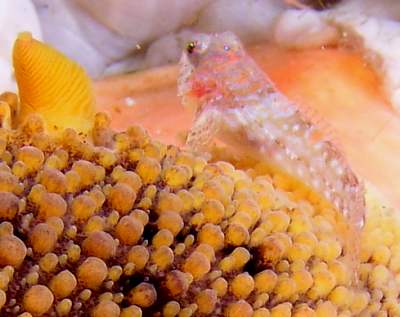
Hi Bill,
We've seen fish with nudibranchs on them, but this is vice versa. This is a juvenile Scaleyhead sculpin, Artedius harringtoni, on the head of a Archidoris montereyensis, while it was mating. It was photographed near Browning Wall, in Port Hardy, British Columbia.
Date: August 2003
Location: Port Hardy, British Columbia
Photograph by: Rand McMein
Cheers,
Marli Wakeling
scubamarli@excite.com
Wakeling, M., 2003 (Sep 4) Archidoris montereyensis with sculpin from Brit. Columbia. [Message in] Sea Slug Forum. Australian Museum, Sydney. Available from http://www.seaslugforum.net/find/10883Thanks Marli,
Bill Rudman
Archidoris montereyensis from Alaska
August 7, 2002
From: Clinton Bauder
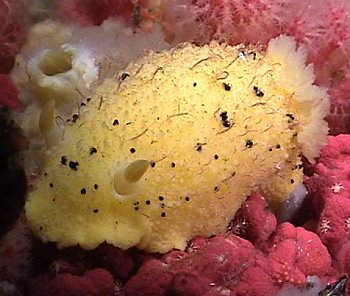
Hi Bill,
This is Archidoris montereyensis. It was taken at St Lazarius Island in Alaska (home to some truly incredible diving) July 2002. Depth was about 15m. Size was about 120mm. Note the hitchhiking arthropods...
Clinton
gecko1@apple.com
Bauder, C., 2002 (Aug 7) Archidoris montereyensis from Alaska. [Message in] Sea Slug Forum. Australian Museum, Sydney. Available from http://www.seaslugforum.net/find/7689Thanks Clinton,
Bill Rudman
Re: Anisodoris nobilis? from British Columbia
March 28, 2002
From: Brian Penney
Yup, Marli's photo is Archidoris montereyensis. Interesting to find it at 45 feet though. I usually find this species shallower. Then again, I am usually in water calm enough for quadrat sampling, which likely makes a difference.
Marli, do you remember what sort of community it was in, what other organisms were around? This information would be extremely helpful.
Cheers,
Brian
bpenney@ualberta.ca
Penney, B., 2002 (Mar 28) Re: Anisodoris nobilis? from British Columbia. [Message in] Sea Slug Forum. Australian Museum, Sydney. Available from http://www.seaslugforum.net/find/6579Thanks Brian,
And thanks to Dave Behrens and Jeff Goddard who both sent messages confirming the photo is of Archidoris montereyensis.
Bill Rudman.
Re: Anisodoris nobilis from British Columbia
March 28, 2002
From: Marli Wakeling
Hi Bill,
Of course your comments are correct, I mixed up 2 slides! This is Archidoris montereyensis, although a small one.
Marli
scubamarli@excite.com
Wakeling, M., 2002 (Mar 28) Re: Anisodoris nobilis from British Columbia. [Message in] Sea Slug Forum. Australian Museum, Sydney. Available from http://www.seaslugforum.net/find/6588Thanks Marli,
Bill Rudman
Anisodoris nobilis? from British Columbia
March 27, 2002
From: Marli Wakeling
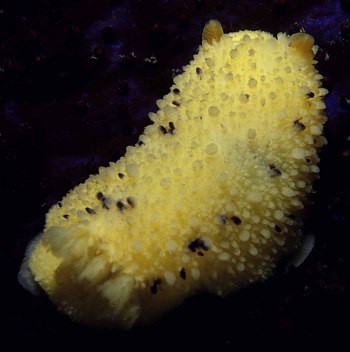
Hi Bill,
Here is Anisodoris nobilis, found commonly in British Columbia. This one was found at Dodd Narrows, near Nanaimo, British Columbia.
PHOTO: Dodd Narrows, near Nanaimo, British Columbia, Canada
DEPTH: 45 feet
LENGTH: 5 cm
DATE: Feb.18,2001
PHOTO BY: Marli Wakeling
Marli
scubamarli@excite.com
Wakeling, M., 2002 (Mar 27) Anisodoris nobilis? from British Columbia. [Message in] Sea Slug Forum. Australian Museum, Sydney. Available from http://www.seaslugforum.net/find/6484Dear Marli,
I think this is Archidoris montereyensis. From earlier messages, Anisodoris nobilis has the dark brown/black on the basal skin of the back, not on the tubercles, and the gills are edged with white. I am sure someone will let us know which one it is.
Best wishes,
Bill Rudman
Re: Oregon Archidoris montereyensis
January 31, 2002
From: Philip Cromwell
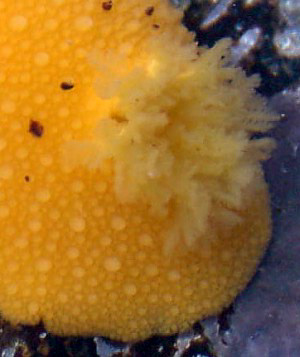
Dear Dr. Bill,
Since I first posted my question about what turned out to be Archidoris montereyensis, I've read through about half of the species list on this site. I'm absolutely fascinated. I never knew there was so much variety and beauty in such strange creatures.
I've attached three close up pictures of my little friend. They are a little blurry, but I hope they add something to your great site. The first is the gill plume. You can see that they are very feathery. The second picture shows the trailing edge of the foot. And, the third show the rhinophores.
I've just started my own page about a few of the temperate ocean animals I had in my aquarium for a while. I've included a lot of links to your site. I hope you don't mind. I really love this stuff.
Cheers,
Phil
chiron42@msn.com
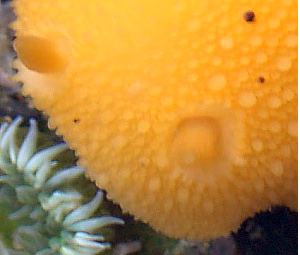
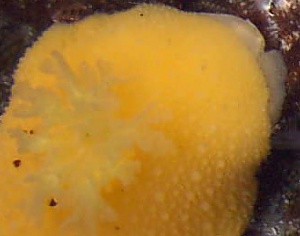
Thanks Philip,
Of course I don't mind you putting links to the Forum on your site. The whole point is to spread the word about these wonderful animals.
Best wishes,
Bill Rudman
Re: Oregon Anisodoris nobilis?
January 10, 2002
From: Phil
Thank you, everyone, for your quick response. After reading through the Archidoris montereyensis thread I have to agree. However, I didn't see any quite as dark as this one. There were both pinkish purple and bright yellow sponges within 100 feet (~30 m) of the tidepool where I found this specimen. Mostly the purple variety, but a few yellow sponges. I was told that they tend to be the color of the sponge that they eat. Is this correct?
Does anyone know where the scientific name comes from? I here they are quite common in the Monterey Bay area of California. If you would like pictures from some other angle, I have about twenty fairly large shots of this little guy. Again, thanks for the info.
Phil
chiron42@msn.com
Phil, 2002 (Jan 10) Re: Oregon Anisodoris nobilis?. [Message in] Sea Slug Forum. Australian Museum, Sydney. Available from http://www.seaslugforum.net/find/5938Dear Phil,
Glad we could solve your problem so painlessly. Many dorids do resemble the colour of their sponge food. Sometimes this is brought about by taking up sponge pigments into their skins but often it seems to be the result of a long evolutionary process which as resulted in the survival of those animals which are best camouflaged.
Archidoris montereyensis was named after Monterey Bay. If you see a scientific name ending in -ensis its means that it is named after the geographic locality preceding the -ensis. For example fijiensis = from Fiji, californiensis = from California etc.
Thanks for your offer of other photos. If you have any that you think help to show the animal or some part of it that would be very welcome.
Best wishes,
Bill Rudman
Anisodoris nobilis? from Oregon
January 9, 2002
From: Phil

Can anyone here positively identify this nudibranch? I found it in a sandy bottomed tidepool near Cape Kiwanda on the Oregon coast [West coast, USA]. There were a lot of sponges on rocks and in tidepools nearby. I believe it is Anisodoris nobilis , but the posts here talk about a white gill plume. This one was orange all over. It was about two inches long.
Thanks,
Phil
chiron42@msn.com
Phil, 2002 (Jan 9) Anisodoris nobilis? from Oregon. [Message in] Sea Slug Forum. Australian Museum, Sydney. Available from http://www.seaslugforum.net/find/5919Dear Phil,
Your west coast 'sea lemons' looked so easy to identify until I saw a few photos. Speaking from a position of total ignorance perhaps this is a yellow form of Archidoris montereyensis?? But really I wouldn't like to hazard a guess. I am sure we won't have to wait long though for someone to give us a more knowledgeable identification.
Bill Rudman
Re: Anisodoris nobilis? from Oregon
January 9, 2002
From: Bruce Wight
Phil,
I think your nudibranch is Archidoris montereyensis, which looks similar to Anisodoris nobilis but the plume is yellow and the black marking are on the turbercles. A. nobilis has a white plume as you mentioned and the black is on the body below the turbercles rather than on the tubercles themselves. Check out the photos of A. montereyensis in the Forum.
Bruce Wight
bwproductions@earthlink.net
Wight, B., 2002 (Jan 9) Re: Anisodoris nobilis? from Oregon. [Message in] Sea Slug Forum. Australian Museum, Sydney. Available from http://www.seaslugforum.net/find/5924Thanks Bruce,
I thought it was probably Archidoris montereyensis but wasn't sure whether I was being tricked by a similarly coloured Dendrodoris or Doriopsilla.
best wishes,
Bill Rudman
Oregon Anisodoris nobilis? is Archidoris montereyensis
January 9, 2002
From: Jeff Goddard
Hi Bill,
Phil's dorid is Archidoris montereyensis. It is distinguished externally from Anisodoris nobilis by the presence of black pigment in the dorsal tubercles, rather than between the tubercles, and by its uniformly yellow gills, as opposed to white-tipped gills. Also, the dorsal tubercles of Archidoris montereyensis are more slender and pointed than those of Anisodoris nobilis.
Best wishes,
Jeff Goddard
goddard@lifesci.ucsb.edu
Goddard, J., 2002 (Jan 9) Oregon Anisodoris nobilis? is Archidoris montereyensis. [Message in] Sea Slug Forum. Australian Museum, Sydney. Available from http://www.seaslugforum.net/find/5926Thanks Jeff,
Bill Rudman
Archidoris montereyensis in California
September 29, 2001
From: Bruce Wight


Hi guys,
I had a great 4 day trip out to Santa Barbara Island, California last week and saw a lot of Archidoris montereyensis with almost linear grouping of black markings running along the top of the dorsal side, usually the black is spattered at random. Thought you might like to see a couple of shots of a couple of the animals. They were all juveniles for they were less 3 cm in length. I also threw in a shot of a gorgeous Phidiana hiltoni that crossed my path and a pair of romantic Anisodoris nobilis all found at the same reef in about 40 feet of water. If you ever go to 7 1/2 fathoms reef on Santa Barbara Island take your macro set up with you.
Take care,
Bruce Wight
bwproductions@earthlink.net
Wight, B., 2001 (Sep 29) Archidoris montereyensis in California. [Message in] Sea Slug Forum. Australian Museum, Sydney. Available from http://www.seaslugforum.net/find/5342Thanks Bruce,
Bill Rudman
More on Sea Lemons
October 14, 2000
From: Clinton Bauder
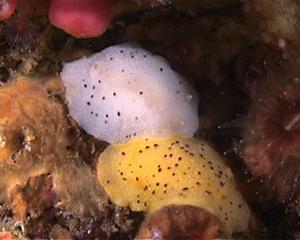
Hi Bill,
I've been reading with interest the discussions on Archidoris montereyensis vs Anisodoris nobilis and I've decided that I couldn't resist muddying the waters further by adding another species: Archidoris odhneri. I occasionally see white specimens of Archidoris montereyensis (UPPER RIGHT). Archidoris odhneri, a large white dorid, is also a commonly seen resident of California waters (LOWER LEFT)
Now since A. odhneri doesn't have spots it seems straightforward enough right? Well I just returned from a trip to British Columbia, Canada, where I saw the beast in my LOWER RIGHT photo. It appears to have a single small black spot in the center of it's back. The color is just slightly yellow. I'm calling it Archidoris montereyensis for now but I could just as easily be convinced that it is A. odhneri which is usually white but is sometimes a very pale yellow.
Copies of the photos are on my website at: http://www.metridium.com/monterey/nudibranchs/archidoris.html
http://www.metridium.com/monterey/nudibranchs/odhneri.html
http://www.metridium.com/bcgallery/archidoris.html
FYI the rest of the British Columbia gallery isn't up and running just yet. With luck it will be there by early next week. For those of you that haven't been diving there let me just say its incredible and among the best diving I've ever done!
Clinton
gecko1@apple.com
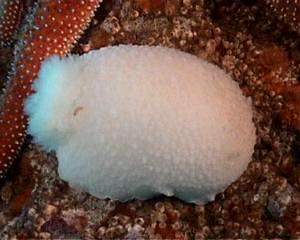
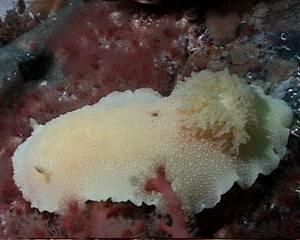
Dear Clinton,
It's fascinating how the sea lemon story has grown from Billy's request for a photo. Hopefully, someone will recognise your animal from British Columbia.
Best wishes,
Bill Rudman.
Note added 22 Oct, 2000: See Sandra Millen's message comparing this group of species and identifying Clinton's top right photo as Geitodoris heathi and bottom right photo as Anisodoris lentiginosa.
Rudman, W.B., 2000 (Oct 14). Comment on More on Sea Lemons by Clinton Bauder. [Message in] Sea Slug Forum. Australian Museum, Sydney. Available from http://www.seaslugforum.net/find/3166Re: Archidoris montereyensis
October 12, 2000
From: Billy
Thank you for your help.
Billy
MMSwinehar@aol.com
Billy, 2000 (Oct 12) Re: Archidoris montereyensis. [Message in] Sea Slug Forum. Australian Museum, Sydney. Available from http://www.seaslugforum.net/find/3160Dear Billy,
There's another message today about sea lemons.
Best wishes,
Bill Rudman.
Archidoris montereyensis & Anisodoris
October 12, 2000
From: Bruce Wight
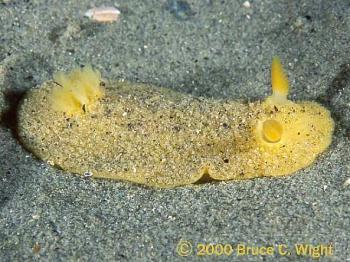
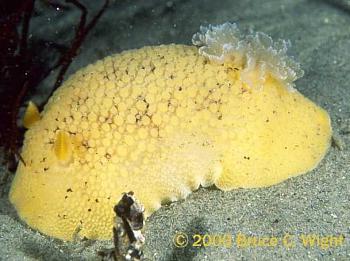
Hi Doc,
Saw your new message on Archidoris montereyensis and thought I could augment the information. Along the California coast we have two dorids that look very similar, both are yellow, both have the pronounced tubercles and are often around the same size. One is Archidoris montereyensis (Upper photo) dusted in sand, as it often times appears, and the other is Anisodoris nobilis (Lower photo). Both of these were taken on the sand in about 25 feet of water at Point Lobos in Monterey California on the same day. As you can see they are very close in appearance. The way I tell them apart is Archidoris has a gill plume that matches its yellow body color and Anisodoris has a white gill plume.
Love your site!
Bruce Wight
bwproductions@earthlink.net
Wight , B. , 2000 (Oct 12) Archidoris montereyensis & Anisodoris. [Message in] Sea Slug Forum. Australian Museum, Sydney. Available from http://www.seaslugforum.net/find/3161Dear Bruce,
Thanks for the photos and the helpful information. I see in Dave Behren's book that another difference is that if there is black or dark brown pigment on the mantle then in Anisodoris it is never on the tubercles, while in Archidoris it often is.
Best wishes,
Bill Rudman.
A photo of Archidoris montereyensis
October 9, 2000
From: Angel Valdes

Dear Bill and Billy,
Here you have a picture of Archidoris montereyensis, taken in Moss
Landing, California. I hope this will be of some help for Billy's project.
Angel
avaldes@CalAcademy.org
Valdes, A., 2000 (Oct 9) A photo of Archidoris montereyensis. [Message in] Sea Slug Forum. Australian Museum, Sydney. Available from http://www.seaslugforum.net/find/3148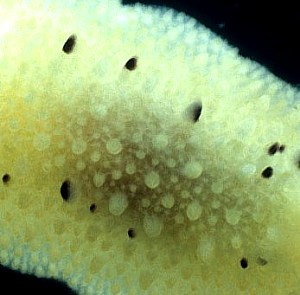
Thanks Ángel,
I've included a larger version of the middle region of the body so that the spicules that form the skeleton in the skin and the tubercles can be seen.
Billy, if you look carefully you will see pale lines in the tubercles (bumps) and also in the skin of the slug's back. Some nudibranchs have quite a network of these calcareous spicules (pointed rods) in their skin which makes it stronger. Usually slugs with spicules have quite a rough, sometimes even a sand-papery feel, while those without spicules are soft and fleshy to touch.
I hope you got plenty of information from the websites I suggested you have a look at.
Best wishes,
Bill Rudman.
Sea Lemon nudibranch
October 7, 2000
From: Billy
Hi my name is Billy and i am a 4th grade student in socal. My class is studying the ocean and we are doing projects on different sea animals. Please send me as much information as possible on the Sea Lemon Nudibranch (Archidoris montereyensis). I need to know it's habitat, what it eats, how it feeds, defends itself, how it reproduces. And I need a few pictures, we need to do a 3d sculpture of this thing some way. Can you help?
Thank you,
Billy
mmswinehar@aol.com
Billy, 2000 (Oct 7) Sea Lemon nudibranch. [Message in] Sea Slug Forum. Australian Museum, Sydney. Available from http://www.seaslugforum.net/find/3111Dear Billy,
I'm afraid I don't have any photos of the nudibranch you are after but maybe one of our Californian friends can help out.
If you go to Erwin Koehler's 'Opisthobranchs of the World' website at
http://www.medslugs.de/Opi/Opisthobranchia.htm you will find a list of all the photos of nudibranchs that Erwin has been able to find on the worldwide web. If you go to the Alphabetical List and look for Archidoris montereyensis you will find there are a few photos at various websites, and some of them have the other information you are looking for.
I hope that helps,
Good Luck with your project,
Bill Rudman.
